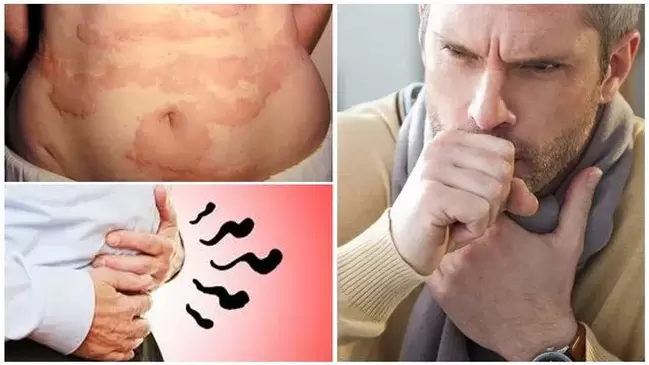Personal hygiene has improved significantly over the last century, but the problem of worms remains relevant not only to rural residents but also to urban dwellers. The statistics make it clear what the risk of helminthic invasion is: one in three people on our planet suffers from helminthiasis. But this disease does not always manifest itself clearly, and in some cases, patients are unable to properly interpret the symptoms and remain in the dark for a long time without taking any action. Questions about understanding the presence of worms arise in both helminthiasis and other pathologies with similar symptoms.

Worms are an extensive group of parasitic worms whose main signs of their presence in the human body are similar. Doctors believe that every person has been exposed to helminthiasis at least once in their life. In addition, the presence of helminths in the body can cause the development of other, sometimes very dangerous, diseases, so the issue of diagnosing the disease is very important.
Mechanisms of infection
Infection with worms occurs in four main ways:
- Water, earth or sand. The soil and water provide ideal conditions for storing parasitic eggs. A person bathing in open water is always at risk of swallowing eggs that later become adults. Not as rare as it seems, people also swallow particles of the earth, exposing themselves to the risk of infection. Certain types of parasites can enter the body directly through the skin.
- Food.Worms are found on the peel of fruits and vegetables that have not been properly washed or cooked. There is no less risk from raw or lightly processed meat, dried fish, dairy products, etc.
- Contact the patient. Direct contact can also occur with a sick person and an infected animal. Common activities, living in a common area, close communication contribute to the rapid entry of parasites into the intestines and their further development.
- Bites.Worms can spread by insect bites. This is one of the rarest modes of infection in temperate latitudes, but sometimes it will be the cause of the disease. In hot countries, this trip is more common to remember when going on vacation to warm lands.
Symptoms
For those who want to know how to understand that they have worms, they need to understand the basics of identifying symptoms. Symptoms of helminthiasis do not appear immediately after infection, but only when the parasite no longer migrates through the gastrointestinal tract and begins to develop into an adult.
Some of the signs are due to the ingestion of toxins released by the worm during its lifetime. All waste products enter the lumen of the gut, from where it is absorbed into the bloodstream and reaches every organ. There are usually more signs and they are stronger in the case of multiple infections when the number of worms becomes significant. In patients with immunosuppressed or other chronic diseases, symptoms worsen in a relatively short period of time.

Each signal is divided into two major groups: explicit and hidden. Explicit ones can be determined independently, at home, while hidden ones can only be established on an outpatient basis, with the help of appointments for certain examinations and tests.
Expressed
Obvious symptoms include those that indicate that worms are present in the body. Their presence does not cause very obvious symptoms, such as the development of viruses. Parasites target life within the body, so an excessive deterioration in the condition of an infected host would be life-threatening. For this reason, the symptoms do not require emergency care.
You can suspect or understand the presence of a helminthic invasion based on the following signs:
- Gradual weight loss for no apparent reason, which lasts for months and even years. The rate of weight loss is not dangerous, most often 2-5% per month. In the case of high intensities of infection in immunocompromised people, this figure can be as high as 10%.
- Disorders of the gastrointestinal tract. Some worms have the ability to block the bile ducts or intestinal lumen, causing stable constipation. On the contrary, with the high intensity of the release of toxins, recurrent diarrhea can occur. Inflammation of the upper wall of the small intestine often results in increased bloating and gas formation, and bloating is possible.
- Severe pain in joints and muscles. Such manifestations are often attributed to the development of arthrosis, but in the case of helminths this is caused by the migration of parasites. In addition, such pain may be caused by the effects of toxins on joints and muscle tissue.
- Itching near the anus. This phenomenon is caused by the fact that most of the parasitic worms crawl out of the rectal lumen to reproduce and lay eggs. This causes severe itching that gets worse in the evenings and at night.
- allergic manifestations. It often occurs when a large number of toxins appear in the blood or due to damage to the intestinal mucosa, which causes an increase in the immune system and an allergic reaction.
- Pulmonary manifestations. It is widely available, from persistent cough to pneumonia. It is characterized by intense ascariasis that occurs within at least three months of the time of infection.
- Elevated temperature. Such manifestations may vary in intensity. Low temperatures around 37 ° C are most common during the day, but in rare cases fever can be observed.

Hidden
Hidden signs can only be revealed by a doctor who properly assesses the clinical picture and is able to understand that worms may be the probable cause. Preventive measures for the diagnosis of helminthiasis include:
- Stool analysis for worms. It has to be submitted in two stages, so the experts do not consider the results of an analysis to be reliable. This is due to the cyclical nature of reproduction, so it is far from always possible to understand from a stool analysis that the patient suffers from helminths.
- Clinical blood test. Elevated levels of eosinophils indicate that parasites are likely to be present in the body. This assumption often arises after testing for the treatment or diagnosis of other diseases.
- Antibody analysis. Currently, this is one of the most reliable diagnostic methods to help you understand if a person has worms. Despite being more expensive than similar drugs, doctors have been increasingly prescribing it recently because of its high information content and reliability.

Antiparasitic drugs or laxatives should not be taken prior to clinical trials for the detection of parasites, as this complicates diagnosis.
Signs in the child
Worms are more often diagnosed in the presence of worms than in adults. This is facilitated by poor hygiene, close contact with domestic or street animals, and poor development of the immune system. A growing organism tends to react more sharply to the presence of parasites, and the consequences may be more global than in adults. But understanding that a child has worms is not easy. Symptoms may be the same as in adults, but are most often more acute.
In most cases, signs of helminthic invasion in children include:
- Fast weight loss. In the case of a running image, such a manifestation can lead to a delay in physical development;
- Deterioration of hair and nails. This is due to a long-term lack of nutrients and vitamins caused by a violation of the intestinal absorption of digested food.
- Sleep disturbance. Due to the pathology, the child wakes up more often at night, crying, spinning and talking in a dream.
- Irritability. Nervous system poisoning and poor health can affect a child’s emotional state, increased irritability, whimsy, tearing, and so on.
- The desire to constantly scratch the anus. Children do not control their external manifestations, so this symptom often helps to understand the cause of diseases and physical changes.

Some parents tend to give their children a wide range of antiparasitic drugs for prevention, but experts do not recommend this because most of these drugs are quite difficult to tolerate. It is better to first understand if the child is infected and what treatment is needed, as the therapies for different types of worms are significantly different and are not always effective for worms in other groups.






































